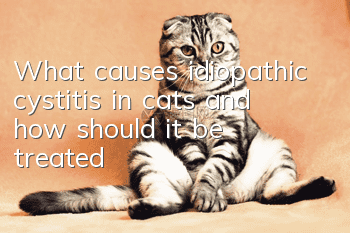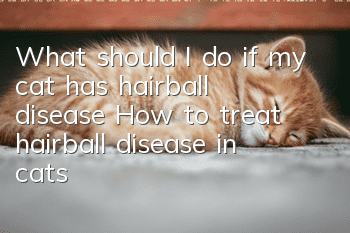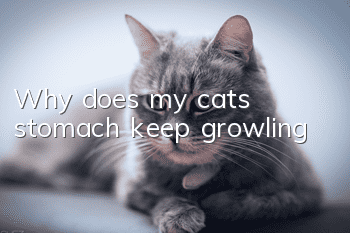What causes idiopathic cystitis in cats and how should it be treated?

Many cat owners will encounter this problem. The cat no longer urinates in the cat litter, but urinates everywhere on the ground. It also urinates frequently and urinates blood. In the past, people always regarded hematuria and frequent urination as stone obstruction, but in fact, 50% of them were caused by idiopathic cystitis! With the development of medicine, we should also have a new understanding of cystitis. .
What is cystitis?
Urinary tract problems in cats include many causes, such as urinary tract infections, sterile or idiopathic cystitis, urinary tract stones, cancer, genetic or congenital problems, and problems with other organs or body systems. Among them, idiopathic cystitis Sexual cystitis is one of the more common lower urinary tract diseases in cats, and the technical term is FIC.
Cystitis is mainly caused by factors such as pathogenic microbial infection, the spread of inflammation in nearby organs, and irritation or damage to the bladder mucosa. "Idiopathic" means that the cause of this condition cannot be determined at present. Although cystitis refers to inflammation of the bladder, there are many causes of cystitis, such as urinary tract infection, urinary tract cancer and bladder stones. Both male and female cats can suffer from cystitis, a chronic disease that is difficult to treat.
What are the symptoms of cystitis?
· Frequent urination
·Make urination postures
· Do not urinate in the litter box
· Urine containing blood, blood clots, mucus, etc.
· Pain and uneasiness when urinating
· The amount of urine passed out is very little or in drops
· Urine is turbid and has a strong ammonia odor
· Bladder pain on palpation
· Increased body temperature, depression, loss of appetite, etc. (when inflammation spreads to tissues or is accompanied by nephritis or ureteritis)
Note: The clinical manifestations of cystitis can also be divided into blockage type and non-blockage type. Each type has different symptoms, and a preliminary judgment can be made. After the next step of examination and understanding of the medical history, more accurate pathogen screening can be carried out through other examinations.
What causes cystitis?
Although cystitis is a disease with no definite cure, these abnormalities are common possible factors in patients with cystitis.
· Bladder lining problems
The bladder's cell layer is a mucus layer made of glycosylated proteins that protect the fragile cells of the bladder wall. Because urine contains many highly concentrated substances, without these protections, it will irritate cells. In cats with cystitis, this lining is defective. May damage cells in the bladder, causing irritation and inflammation.
· Neurogenic inflammation
Nerves in the bladder wall may be stimulated locally by the lining of the bladder or by stimulation (pressure) from the brain. Stimulation of these nerves causes the release of neurotransmitters, which increases local inflammation and pain.
· Pressure
In cats with cystitis, many things are caused by stress. Although it is difficult to directly correlate, there are many signs that cats who are kept indoors alone, or cats in multi-cat households, are more likely to cause cystitis. example.
·Abnormal stress response
There is ample evidence that cats can develop cystitis under the influence of stress, which often triggers the release of epinephrine, norepinephrine, and cortisol. In cats with cystitis, they actually have a lower than normal cortisol response.
· Cat food lacks moisture
When the moisture content of cat food is 8%-10%, it is already lacking in moisture. At this time, the cat will produce more concentrated urine, and the urine output will also decrease, causing stones to form, and eventually cystitis. And many of the current urinary tract prescription foods are extremely high in carbohydrates. We should choose carefully. Although diet is not the only way to control cystitis, it is a point we can control.
How is cystitis diagnosed?
There are currently no diagnostic tests that can directly confirm that a cat has cystitis. The diagnosis can only be made by ruling out other diseases that may cause similar symptoms, the cat's medical history, clinical symptoms, bladder palpation changes, and urine test results.
·Urine test
A urine test is the most important step in diagnosis and includes tests for blood, crystals, proteins and other abnormalities, as well as testing for pH. When the urine is mixed with a large number of white blood cells and appears turbid, it is pyuria; when it is brown, it is hematuria with an ammonia odor. When bacteria are found in the urine, the bladder is infected. When fungi are detected in the urine, fungiuria appears, indicating a fungal infection. If pyuria, hematuria, proteinuria, and bacteriuria appear at the same time, it indicates a urinary tract infection.
· Blood test
Includes complete blood count and chemistry profile. Generally speaking, cystitis does not have an increase in white blood cells and a left shift of neutrophils. These differences distinguish pyelonephritis and prostatitis.
·X-ray inspection
Abdominal X-ray or ultrasound of the bladder to rule out stones and other abnormal structures in the bladder. This test can diagnose complications such as urinary stones, tumors, urethral abnormalities, intravesical diverticula, and chronic cystitis.
What is the treatment for cystitis?
The following is for reference only. The specific medication needs to be based on the plan given by the doctor after diagnosis.
· Improve your diet
Let cats get proper rest, feed them non-irritating, nutritious, high-quality food, and ensure adequate and clean water. And reduce the intake of high-protein foods.
· Clean the urination port
First rinse the bladder repeatedly with warm saline, and then rinse with medicinal solution. For example, for the purpose of disinfection, 0.1% potassium permanganate solution (or 2% boric acid solution, 0.02% nitrofurazone solution) can be used. For the purpose of astringency, 1%~2% alum solution (or tannic acid solution) can be used. Chronic cystitis can be treated with 0.02% to 0.1% silver nitrate solution.
· Control infection/eliminate inflammation
Antibiotics, quinolones, sulfonamides and antifungal drugs can be used. In the case of severe bleeding, systemic hemostatic drugs can be used, such as Adrenal Hydrazone (Anluoxue) 0.1~0.3 mg/kg, twice a day. Or fenethylamine (hemostatic sensitivity) 5~15mg/kg, 2 times a day, intramuscular injection.
· Increase water intake
Once a cat has concentrated urine and difficulty urinating, it will increase the burden on the kidneys. When the cat food they eat is lacking in water, the urine output will be less and they are prone to stones. Therefore, they should increase their water intake and improve the cat's urinary function. food to dilute the urine to improve the condition.
Effective prevention methods
· Increase the amount of water you drink. Drinking more water can help dilute the urine, thereby speeding up the resolution of symptoms;
· Place several clean water bowls in the room, or prepare a fountain or drip water dispenser;
· Do not use tap water directly;
· Provide a sufficient number of litter boxes, one for each cat;
· Keep the cat litter box dry and clean;
· Place the litter box in a quiet location so that the cat will not be disturbed while using it;
· Eating canned food can help cats increase water consumption
· Reduce stress to relieve stress in cats, especially in multi-cat households.
Tips:
Many people think of cystitis as an easily treatable condition, but it can even be life-threatening if the urethra is blocked and you are unable to urinate. Therefore, during the treatment process, if new symptoms appear or you still feel uncomfortable, you need to contact your doctor immediately to prevent recurrent cystitis; long-term management is also very important, so be sure to complete the entire treatment process according to your doctor's instructions.
- Does a cat want its owner to accompany it before it dies?
- Cat vomited and stopped eating after changing cat food
- How to quickly make a cat trust its new owner
- Can cats suffer from asthma like people?
- The cat suddenly convulsed and ran around
- Does a female cat meow when she's in heat?
- Why are the ears of a 2-month-old kitten dirty?
- Why do cats pee randomly? How to correct this habit?
- Why do cats purr?
- How to prevent toxoplasmosis in tabby cats, toxoplasmosis in dogs and cats and their prevention!



